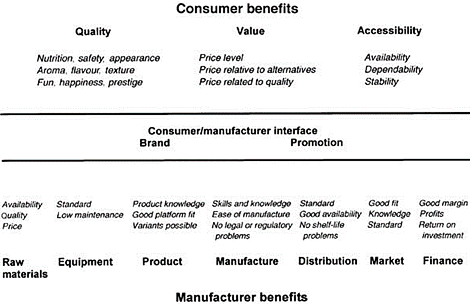FOOD
PRODUCT DEVELOPMENT
Mary Earle, Richard Earle and Allan Anderson |
| Loading
|
|
||||
|
|
Part
I,
Chapter 1
Keys to new product success and failure 1.2.1 Individual product success Individual product success can be measured by financial success, consumer and market success, production success, product/consumer (customer) success. Financial measures are usually the profits and return on investment. These appear quantitative but they are often fraught with problems. How is the measurement made? Is it the return on investment over one, five or ten years? Does it include the basic research that preceded the product development and perhaps spreads over several present and future products? What is the method of discounting the returns over a 10-year period? There is a great deal written in the product development literature about predicting financial success before launching but not a great deal on financial evaluation after the launch (Crawford, 1997). Obviously at the company level, the annual balance sheet for shareholders is where the company is judged. But how does this relate specifically to the product development? If it has a product family financial analysis, showing different product families as percentages of the profits, then how the product changes are affecting profitability can be analysed. If the investments in the various product families are recorded then the return on investment in various product families can be determined. But it is seldom possible to track individual products from the annual balance sheet. In product development, a financial benchmark is set which takes into consideration not only the company's own financial needs from a product family but also the financial standards being set by other companies. All the individual products in a product family are often set, for simplicity, the same financial targets, but this may be a false assumption as specific products may have different aims. Market success, achieving target sales volumes and revenues, is often the measure of success and failure for the overall company, the product families and the individual products. They are usually easy to measure - or are they? Sales are related to time, the marketing effort and the conditions in the market. A simple yearly sales achievement may not relate to the quality or the uniqueness of the product, nor give a true indication of the product development success. Sales over time need to be measured, along with any competing products in the market, and also the other products in the company's product family, together with a breakdown to the different market segments. In industrial marketing to the food manufacturer and the food service company, not only are the actual ingredient sales monitored but also the sales of the resulting consumer products to confirm if the company is achieving its percentage of a growing or static market. The efficiency of the marketing effort to achieve these sales is also a product success measure - the costs of the marketing effort including distribution, advertising and promotion and selling are measured and related to the sales achieved. Production success is usually analysed by quantity, quality and costs. It has to achieve the product quality in the product specification consistently with only a prescribed variation, to ensure product safety, and also to produce at the correct quantity and time. It has basic production costs that have to be achieved, and the investment capital and the working capital of the process and production development have to be within budget and time. One of the most important measures is the production yield, the ratio of the product output to the raw materials input. The distribution losses and the returns from the retailers are also measured and are very important in the food industry. Product and consumer (customer) success is measured by the level of consumer or customer acceptance and also by the position of the new product against the competing products. The total product success is determined by how quickly it is bought, how often it is bought and how much is bought, but there needs to be more detailed analysis. The product is set target standards in the product design specifications, and its success is rated according to how it achieves these standards. It is not just a consumer rating of the product's acceptance but in particular how much it has incorporated the benefits identified as the consumer needs, how much it has achieved uniqueness to the consumer, how much value it is to the consumers. There will also be specific quantitative measures of the product characteristics as identified in the company's product specifications - have they been met? The consumer's and the manufacturer's benefits as shown in Fig. 1.3 need to be identified and measured. In the case of the industrial product, the criteria for success are based on how the product performed in the buyer's process and how it related to the quality of the final consumer product. Very often for industrial ingredients for food manufacturers and for large food service companies, there are strict product specifications and the product quality has to be within a specific range.  Fig. 1.3 Benefits as seen by the consumer and the manufacturer. |
|
 |